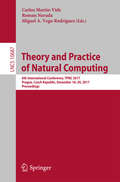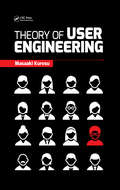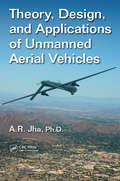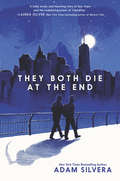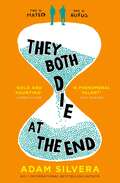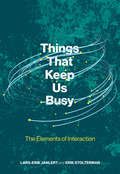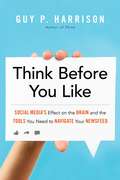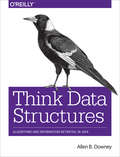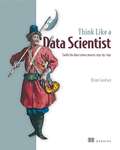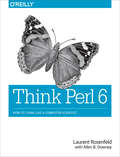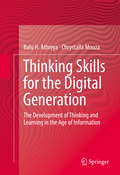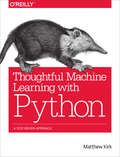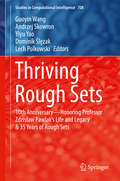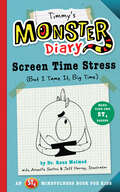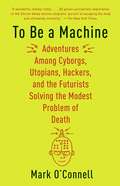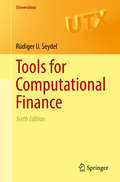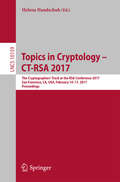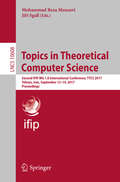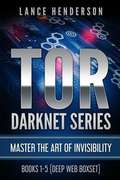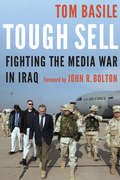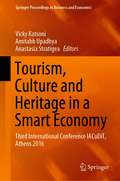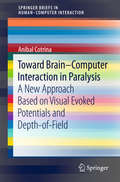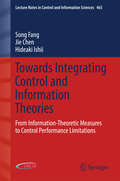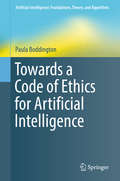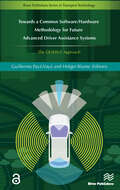- Table View
- List View
Theory and Practice of Natural Computing
by Carlos Martín-Vide Miguel A. Vega-Rodríguez Roman NerudaThis book constitutes the refereed proceedings of the 6th International Conference,on Theory and Practice of Natural Computing, TPNC 2017, held in Prague, Czech Republic, December 2017.The 22 full papers presented in this book, together with one invited talk, werecarefully reviewed and selected from 39 submissions. The papers are organized around the following topical sections: applications of natural computing; evolutionary computation; fuzzy logic; Molecular computation; neural networks; quantum computing.
Theory of User Engineering
by Masaaki KurosuThis book outlines the new concept of user engineering and covers the diversity of users, along with the business process that includes the design and the user’s experience processes. Although the concept of user experience (UX) has become popular, the definition and the methodology are still ambiguous. User engineering is similar to the user-centered design, but differs in that its scope is not limited to the design process but concerns the whole manufacturing process and the whole usage process, i.e., the whole lifecycle of an artifact. User’s perspective is strongly emphasized in this book, hence, its stance is far from that of the marketing approach that usually fails to notice the life and experiences of users after the purchase of an artifact as consumers. Theory of User Engineering differentiates between the quality in design and the quality in use, and the objective quality characteristics and the subjective quality characteristics. In addition to the user research using ethnographic methods, the author introduces a new approach based on the artifact evolution theory that can be adopted in the planning stage.
Theory, Design, and Applications of Unmanned Aerial Vehicles
by A. R. Jha, Ph.D.This book provides a complete overview of the theory, design, and applications of unmanned aerial vehicles. It covers the basics, including definitions, attributes, manned vs. unmanned, design considerations, life cycle costs, architecture, components, air vehicle, payload, communications, data link, and ground control stations. Chapters cover types and civilian roles, sensors and characteristics, alternative power, communications and data links, conceptual design, human machine interface, sense and avoid systems, civil airspace issues and integration efforts, navigation, autonomous control, swarming, and future capabilities.
They Both Die at the End: The Uk No. 1 Bestseller!
by Adam Silvera<P>From the bestselling author of HISTORY IS ALL YOU LEFT ME comes another unforgettable story of life, loss and making each day count <P>On September 5th, a little after midnight, Death-Cast calls Mateo Torrez and Rufus Emeterio to give them some bad news: they're going to die today. Mateo and Rufus are total strangers, but, for different reasons, they're both looking to make a new friend on their End Day. The good news: there's an app for that. It's called the Last Friend, and through it, Rufus and Mateo are about to meet up for one last great adventure - to live a lifetime in a single day. <P><b>A New York Times Bestseller</b>
They Both Die at the End: TikTok made me buy it! (They Both Die at the End series)
by Adam SilveraThe first book in the No. 1 global bestselling They Both Die at the End series. What if you could find out your death date from a single phone call? Death-Cast is calling . . . will you answer? &‘If They Both Die at the End broke your heart and put it back together again, be prepared for this novel to do the same. A tender, sad, hopeful and youthful story that deserves as much love as its predecessor.&’ Culturefly '[A] heart-pounding story [full] of emotion and suspense.' Kirkus 'An extraordinary book with a riveting plot.' BooklistA love story with a difference - an unforgettable tale of life, loss and making each day count. On September 5th, a little after midnight, Death-Cast calls Mateo Torrez and Rufus Emeterio to give them some bad news: they're going to die today. Mateo and Rufus are total strangers, but, for different reasons, they're both looking to make a new friend on their End Day. The good news: there's an app for that. It's called the Last Friend, and through it, Rufus and Mateo are about to meet up for one last great adventure - to live a lifetime in a single day. Another beautiful, heartbreaking and life-affirming book from the brilliant Adam Silvera, author of More Happy Than Not, History Is All You Left Me, What If It's Us, Here's To Us and the Infinity Cycle series.PRAISE FOR ADAM SILVERA: 'There isn't a teenager alive who won't find their heart described perfectly on these pages.' Patrick Ness, author of The Knife of Never Letting Go 'Adam Silvera is a master at capturing the infinite small heartbreaks of love and loss and grief.' Nicola Yoon, author of Everything, Everything 'A phenomenal talent.' Juno Dawson, author of Clean and Wonderland 'Bold and haunting.' Lauren Oliver, author of Delirium
Things That Keep Us Busy: The Elements of Interaction (The\mit Press Ser.)
by Erik Stolterman Lars-Erik JanlertAn investigation of interactivity, interfaces and their design, and the webs of complex interactions that result.We are surrounded by interactive devices, artifacts, and systems. The general assumption is that interactivity is good—that it is a positive feature associated with being modern, efficient, fast, flexible, and in control. Yet there is no very precise idea of what interaction is and what interactivity means. In this book, Lars-Erik Janlert and Erik Stolterman investigate the elements of interaction and how they can be defined and measured. They focus on interaction with digital artifacts and systems but draw inspiration from the broader, everyday sense of the word.Viewing the topic from a design perspective, Janlert and Stolterman take as their starting point the interface, which is designed to implement the interaction. They explore how the interface has changed over time, from a surface with knobs and dials to clickable symbols to gestures to the absence of anything visible. Janlert and Stolterman examine properties and qualities of designed artifacts and systems, primarily those that are open for manipulation by designers, considering such topics as complexity, clutter, control, and the emergence of an expressive-impressive style of interaction. They argue that only when we understand the basic concepts and terms of interactivity and interaction will we be able to discuss seriously its possible futures.
Think Before You Like: Social Media's Effect on the Brain and the Tools You Need to Navigate Your Newsfeed
by Guy P. HarrisonAt a time when the news cycle turns on a tweet, journalism gets confused with opinion, and facts are treated as negotiable information, applying critical thinking skills to your social media consumption is more important than ever.Guy P. Harrison, an upbeat advocate of scientific literacy and positive skepticism, demonstrates how critical thinking can enhance the benefits of social media while giving users the skills to guard against its dangers.Social media has more than two billion users and continues to grow. Its widespread appeal as a means of staying in touch with friends and keeping up with daily news masks some serious pitfalls-- misinformation, pseudoscience, fraud, propaganda, and irrational beliefs, for example, presented in an attractive, easy-to-share form. This book will teach you how to resist the psychological and behavioral manipulation of social media and avoid the mistakes that millions have already made and now regret.Harrison presents scientific studies that show why your subconscious mind loves social media and how that can work against your ability to critically evaluate information. Among other things, social media reinforces your biases, clouds your judgment with images that leave a false impression, and fills your brain with anecdotes that become cheap substitutes for objective data. The very nature of the technology keeps you in a bubble; by tracking your preferences it sends only filtered newsfeeds, so that you rarely see anything that might challenge your set notions. Harrison explores the implications of having digital "friends" and the effects on mood, self-esteem, and the cultivation of friendship in the real world. He discusses how social media affects attention spans and the ability to consider issues in depth. And he suggests ways to protect yourself against privacy invasion, cyberstalking, biased misinformation, catfishing, trolls, misuse of photos, and the confusion over fake news versus credible journalism.
Think Data Structures: Algorithms and Information Retrieval in Java
by Allen B. DowneyIf you’re a student studying computer science or a software developer preparing for technical interviews, this practical book will help you learn and review some of the most important ideas in software engineering—data structures and algorithms—in a way that’s clearer, more concise, and more engaging than other materials.By emphasizing practical knowledge and skills over theory, author Allen Downey shows you how to use data structures to implement efficient algorithms, and then analyze and measure their performance. You’ll explore the important classes in the Java collections framework (JCF), how they’re implemented, and how they’re expected to perform. Each chapter presents hands-on exercises supported by test code online.Use data structures such as lists and maps, and understand how they workBuild an application that reads Wikipedia pages, parses the contents, and navigates the resulting data treeAnalyze code to predict how fast it will run and how much memory it will requireWrite classes that implement the Map interface, using a hash table and binary search treeBuild a simple web search engine with a crawler, an indexer that stores web page contents, and a retriever that returns user query resultsOther books by Allen Downey include Think Java, Think Python, Think Stats, and Think Bayes.
Think Like a Data Scientist: Tackle the data science process step-by-step
by Brian GodseySummaryThink Like a Data Scientist presents a step-by-step approach to data science, combining analytic, programming, and business perspectives into easy-to-digest techniques and thought processes for solving real world data-centric problems.Purchase of the print book includes a free eBook in PDF, Kindle, and ePub formats from Manning Publications.About the TechnologyData collected from customers, scientific measurements, IoT sensors, and so on is valuable only if you understand it. Data scientists revel in the interesting and rewarding challenge of observing, exploring, analyzing, and interpreting this data. Getting started with data science means more than mastering analytic tools and techniques, however; the real magic happens when you begin to think like a data scientist. This book will get you there.About the BookThink Like a Data Scientist teaches you a step-by-step approach to solving real-world data-centric problems. By breaking down carefully crafted examples, you'll learn to combine analytic, programming, and business perspectives into a repeatable process for extracting real knowledge from data. As you read, you'll discover (or remember) valuable statistical techniques and explore powerful data science software. More importantly, you'll put this knowledge together using a structured process for data science. When you've finished, you'll have a strong foundation for a lifetime of data science learning and practice.What's InsideThe data science process, step-by-stepHow to anticipate problemsDealing with uncertaintyBest practices in software and scientific thinkingAbout the ReaderReaders need beginner programming skills and knowledge of basic statistics.About the AuthorBrian Godsey has worked in software, academia, finance, and defense and has launched several data-centric start-ups.Table of ContentsPART 1 - PREPARING AND GATHERING DATA AND KNOWLEDGEPhilosophies of data scienceSetting goals by asking good questionsData all around us: the virtual wildernessData wrangling: from capture to domesticationData assessment: poking and proddingPART 2 - BUILDING A PRODUCT WITH SOFTWARE AND STATISTICSDeveloping a planStatistics and modeling: concepts and foundationsSoftware: statistics in actionSupplementary software: bigger, faster, more efficientPlan execution: putting it all togetherPART 3 - FINISHING OFF THE PRODUCT AND WRAPPING UPDelivering a productAfter product delivery: problems and revisionsWrapping up: putting the project away
Think Perl 6: How to Think Like a Computer Scientist
by Allen B. Downey Laurent RosenfeldWant to learn how to program and think like a computer scientist? This practical guide gets you started on your programming journey with the help of Perl 6, the younger sister of the popular Perl programming language. Ideal for beginners, this hands-on book includes over 100 exercises with multiple solutions, and more than 1,000 code examples so you can quickly practice what you learn. Experienced programmers—especially those who know Perl 5—will also benefit.Divided into two parts, Think Perl 6 starts with basic concepts that every programmer needs to know, and then focuses on different programming paradigms and some more advanced programming techniques. With two semesters’ worth of lessons, this book is the perfect teaching tool for computer science beginners in colleges and universities.Learn basic concepts including variables, expressions, statements, functions, conditionals, recursion, and loopsUnderstand commonly used basic data structures and the most useful algorithmsDive into object-oriented programming, and learn how to construct your own types and methods to extend the languageUse grammars and regular expressions to analyze textual contentExplore how functional programming can help you make your code simpler and more expressive
Thinking Skills for the Digital Generation
by Balu H. Athreya Chrystalla MouzaThis important text synthesizes the state of knowledge related to thinking and technology and provides strategies for helping young people cultivate thinking skills required to navigate the new digital landscape. The rise of technology has resulted in new ways of searching and communicating information among youth, often creating information "overload". We do not know how the new technologies will affect the ways young people learn and think. There are plenty of warnings about the dangers of information technology, but there is also enormous potential for technology to aid human thinking, which this book explores from an open-minded perspective. Coverage Includes: - An up to date review of the literature on thinking skills in general, and in relation to technology. - Practical guidelines for thinking with technology. - A scholarly review of the characteristics of the digital generation. - A discussion of the various steps involved in the thinking process. - A historical context of the Information Age and the transition from oral history, to printing press, to the Internet. Thinking Skills for the Digital Generation: The Development of Thinking and Learning in the Age of Information is an invaluable reference for educators and research professionals particularly interested in educational technology, and improving thinking and problem-solving skills.
Thoughtful Machine Learning with Python: A Test-Driven Approach
by Matthew KirkGain the confidence you need to apply machine learning in your daily work. With this practical guide, author Matthew Kirk shows you how to integrate and test machine learning algorithms in your code, without the academic subtext.Featuring graphs and highlighted code examples throughout, the book features tests with Python’s Numpy, Pandas, Scikit-Learn, and SciPy data science libraries. If you’re a software engineer or business analyst interested in data science, this book will help you:Reference real-world examples to test each algorithm through engaging, hands-on exercisesApply test-driven development (TDD) to write and run tests before you start codingExplore techniques for improving your machine-learning models with data extraction and feature developmentWatch out for the risks of machine learning, such as underfitting or overfitting dataWork with K-Nearest Neighbors, neural networks, clustering, and other algorithms
Thriving Rough Sets
by Dominik Ślęzak Yiyu Yao Andrzej Skowron Guoyin Wang Lech PolkowskiThis special book is dedicated to the memory of Professor Zdzisław Pawlak, the father of rough set theory, in order to commemorate both the 10th anniversary of his passing and 35 years of rough set theory. The book consists of 20 chapters distributed into four sections, which focus in turn on a historical review of Professor Zdzisław Pawlak and rough set theory; a review of the theory of rough sets; the state of the art of rough set theory; and major developments in rough set based data mining approaches. Apart from Professor Pawlak's contributions to rough set theory, other areas he was interested in are also included. Moreover, recent theoretical studies and advances in applications are also presented. The book will offer a useful guide for researchers in Knowledge Engineering and Data Mining by suggesting new approaches to solving the problems they encounter.
Timmy's Monster Diary: Screen Time Stress (But I Tame It, Big Time) (Monster Diaries #2)
by Raun Melmed Annette SextonMeet Timmy, a lovable monster who can’t get enough of the coolest gadgets and video games. Too bad he doesn’t realize how much time he spends each day in front of a screen. In the same humorous spirit of Diary of a Wimpy Kid comes Timmy’s Monster Diary: Screen Time Stress. Using the “Time-Telling” and “ST4” techniques developed by Dr. Raun Melmed of the Melmed Center in Arizona, Timmy’s Monster Diary teaches kids how to self-monitor the amount of time they spend on technology. Timmy’s hilarious doodles and diary entries chronicle his delightful adventures, misadventures, and eventual triumph in a funny, relatable way. It’s the one book that kids will want to turn off the TV and read! Timmy’s Monster Diary also includes a resource section to help parents and teachers implement Dr. Melmed’s methods, plus ST4 reminders that kids can remove, color, and place around the house. Ages 6–12 Don’t miss Marvin’s ADHD adventures in Book 1.
To Be a Machine: Adventures Among Cyborgs, Utopians, Hackers, and the Futurists Solving the Modest Problem of Death
by Mark O'ConnellAn eye-opening journey into a world of visionaries, billionaires, and eccentrics harnessing technology for nothing less than the salvation of mankindTranshumanism is a movement pushing the limits of our bodies—our capabilities, intelligence, and lifespans—in the hopes that, through technology, we can become something better than ourselves. It has found support among Silicon Valley billionaires and some of the world’s biggest businesses. In To Be a Machine, journalist Mark O'Connell explores the staggering possibilities and moral quandaries that present themselves when you of think of your body as a device. He visits the world's foremost cryonics facility to witness how some have chosen to forestall death. He discovers an underground collective of biohackers, implanting electronics under their skin to enhance their senses. He meets a team of scientists urgently investigating how to protect mankind from artificial superintelligence.Where is our obsession with technology leading us? What does the rise of AI mean not just for our offices and homes, but for our humanity? Could the technologies we create to help us eventually bring us to harm? Addressing these questions, O'Connell presents a profound, provocative, often laugh-out-loud-funny look at an influential movement. In investigating what it means to be a machine, he offers a surprising meditation on what it means to be human.
Tools for Computational Finance
by Rüdiger U. SeydelComputational and numerical methods are used in a number of ways across the field of finance. It is the aim of this book to explain how such methods work in financial engineering. By concentrating on the field of option pricing, a core task of financial engineering and risk analysis, this book explores a wide range of computational tools in a coherent and focused manner and will be of use to anyone working in computational finance. Starting with an introductory chapter that presents the financial and stochastic background, the book goes on to detail computational methods using both stochastic and deterministic approaches.Now in its sixth edition, Tools for Computational Finance has been significantly revised and contains: Several new parts such as a section on extended applications of tree methods, including multidimensional trees, trinomial trees, and the handling of dividends;Additional material in the field of generating normal variates with acceptance-rejection methods, and on Monte Carlo methods;115 exercises, and more than 100 figures, many in color.Written from the perspective of an applied mathematician, all methods are introduced for immediate and straightforward application. A ‘learning by calculating’ approach is adopted throughout this book, enabling readers to explore several areas of the financial world.Interdisciplinary in nature, this book will appeal to advanced undergraduate and graduate students in mathematics, engineering, and other scientific disciplines as well as professionals in financial engineering.
Topics in Cryptology – CT-RSA 2017
by Helena HandschuhThis book constitutes the refereed proceedings of the Cryptographer's Track at the RSA Conference 2017, CT-RSA 2017, held in San Francisco, CA, USA, in February 2017. The 25 papers presented in this volume were carefully reviewed and selected from 77 submissions. CT-RSA has become a major publication venue in cryptography. It covers a wide variety of topics from public-key to symmetric key cryptography and from cryptographic protocols to primitives and their implementation security. This year selected topics such as cryptocurrencies and white-box cryptography were added to the call for papers.
Topics in Theoretical Computer Science
by Mohammad Reza Mousavi Jiří SgallThis book constitutes the refereed proceedings of the Second IFIP WG 1. 8 International Conference on Topics in Theoretical Computer Science, TTCS 2017, held in Tehran, Iran, in September 2017. The 8 papers presented in this volume were carefully reviewed and selected from 20 submissions. They were organized in topical sections named: algorithms and complexity; and logic, semantics, and programming theory.
Tor Darknet: Master the Art of Invisibility
by Lance HendersonWant to surf the web anonymously? Cloak yourself in shadow? I will show you how to become a ghost in the machine - leaving no tracks back to your ISP. This book covers it all! Encrypting your files, securing your PC, masking your online footsteps with Tor browser, VPNs, Freenet and Bitcoins, and all while giving you peace of mind with TOTAL 100% ANONYMITY. - How to Be Anonymous Online AND Offline - Step by Step Guides for Tor, Freenet, I2P, VPNs, Usenet and more - Browser Fingerprinting - Anti-Hacking and Counter-forensics Techniques - Photo & Video Metadata - How to Encrypt Files (I make this super simple) - How to Defeat NSA Spying - How to Browse the Deep Web - How to Protect Your Identity - How to Hide Anything! Tor & The Dark Art of Anonymity The NSA hates Tor. So does the FBI. Even Google wants it gone, as do Facebook and Yahoo and every other soul-draining, identity-tracking vampiric media cartel that scans your emails and spies on your private browsing sessions to better target you - but there's hope. This manual will give you the incognito tools that will make you a master of anonymity! Covered in Tor: - Browse the Internet Anonymously - Darkcoins, Darknet Marketplaces & Opsec Requirements - Tor Hidden Servers - How to Not Get Caught - Counter-Forensics the FBI Doesn't Want You to Know About! - Windows vs. Linux Network Security - Cryptocurrency (Real Bitcoin Anonymity) - Supercookies & Encryption - Preventing Marketers and Debt Collectors From Finding You - How to Protect Your Assets - Home, Money & Family! - How to Hide Anything from even the most trained IRS agents The Invisibility Toolkit Within this book lies top secrets known only to the FBI and a few law enforcement agencies: How to disappear in style and retain assets. How to switch up multiple identities on the fly and be invisible such that no one; not your ex, not your parole officer, nor even the federal government can find you. Ever. You'll learn: - How to disappear overseas - How to wear a perfect disguise. - How to bring down a drone. - How to be invisible in Canada, Thailand, China or the Philippines. - How to use Darkcoins on the run. - How to fool skip tracers, child support courts, student loan collectors - How to sneak into Canada - How to be anonymous online using Tor, Tails and the Internet Underground - Edward Snowden's biggest mistake. Usenet: The Ultimate Guide The first rule of Usenet: Don't Talk About Usenet! But times have changed and you want what you want. Usenet is the way to go. I will show you: - How to use Usenet - which groups to join, which to avoid - How to be anonymous online - Why Usenet is better than torrents - How to use Tor, How to use PGP, Remailers/Mixmaster, SSL. - How to encrypt your files - Which Vpn and Usenet companies rat you out, and which won't. - How to Stay Anonymous Online You've probably read The Hacker Playbook by Peter Kim and the Art of Invisibility by Kevin Mitnick. While those are fine books, you need this super pack to take it to the NEXT LEVEL. Scroll to the top of the page and select the "buy" button and wear a cloak of invisibility INSTANTLY!
Tough Sell: Fighting the Media War in Iraq
by John R. Bolton Tom BasileLike the War on Terror, the Media War rages on. More than ever, America’s ability to fight and win against ISIS requires that we understand how best to communicate about war in the digital age. Tom Basile takes readers behind the scenes during his time as a civilian advisor in Iraq during the Iraq War, describing his mission and the struggle to communicate about the war as it became more deadly and less popular at home. The U.S.-led coalition wasn’t merely engaged in a fight to build a more tolerant, participatory society against incredible odds. It was also in a constant clash with forces that influenced public perception about the mission. During those difficult years, it became clear that warfare was now, more than ever, a blend of policy, politics, and the business of journalism. Basile critiques the media’s reporting and assesses the Bush administration’s home-front communications strategy to argue that if policymakers fail to effectively articulate their strategy, manage their message, and counter misinformation, they will find themselves unable to execute that policy. That, Basile argues, places the United States at great risk. Tough Sell blends Basile’s personal story with lessons from the media war in Iraq that can improve our ability to communicate about and prosecute the War on Terror.
Tourism, Culture and Heritage in a Smart Economy: Third International Conference IACuDiT, Athens 2016 (Springer Proceedings in Business and Economics)
by Vicky Katsoni Anastasia Stratigea Amitabh UpadhyaThis book explores the ways in which information and communication technologies (ICTs) offer a powerful tool for the development of smart tourism. Numerous examples are presented from across the entire spectrum of cultural and heritage tourism, including art, innovations in museum interpretation and collections management, cross-cultural visions, gastronomy, film tourism, dark tourism, sports tourism, and wine tourism. Emphasis is placed on the importance of the smart destinations concept and a knowledge economy driven by innovation, creativity, and entrepreneurship. New modes of tourism management are described, and tourism products, services, and strategies for the stimulation of economic innovation and promotion of knowledge transfer are outlined. The potential of diverse emerging ICTs in this context is clearly explained, covering location-based services, internet of things, smart cities, mobile services, gamification, digital collections and the virtual visitor, social media, social networking, and augmented reality. The book is edited in collaboration with the International Association of Cultural and Digital Tourism (IACuDiT) and includes the proceedings of the Third International Conference on Cultural and Digital Tourism.
Toward Brain-Computer Interaction in Paralysis
by Anibal CotrinaThis book presents up-to-date information on Brain-computer Interfaces (BCI). BCIs are systems that record brain signals, extract features and translate them into computer commands. For instance, in BCIs based on the steady-state visual evoked potentials (SSVEP-BCI), brain potentials evoked by visual stimuli are used for controlling computer-based devices. Inspired by the optical phenomenon of depth of field, this book introduces, describes, and evaluates a novel way of setting visual stimuli for SSVEP-BCI. It employs two stimuli that were placed at different distances from the subjects so that if one stimulus is focused on, the other one is non-focused. This assessment allows SSVEP-BCI users to modulate their brain signals by shifting their focus because focused and non-focused stimuli evoke different brain potentials. It allows people to send two brain commands with high accuracy rate by shifting their focus. Hence, computer interaction systems can be proposed for people with paralysis, such as patients with amyotrophic lateral sclerosis since focusing mechanism does not demand head, neck, or eyeball movements. The matter assessed in this book that includes offline and online experiments, is useful for researchers in human-machine interaction who are looking for relevant possibilities of improving the quality of life of people in paralysis situation.
Towards Integrating Control and Information Theories
by Jie Chen Song Fang Hideaki IshiiThis book investigates the performance limitation issues in networked feedback systems. The fact that networked feedback systems consist of control and communication devices and systems calls for the integration of control theory and information theory. The primary contributions of this book lie in two aspects: the newly-proposed information-theoretic measures and the newly-discovered control performance limitations. We first propose a number of information notions to facilitate the analysis. Using those notions, classes of performance limitations of networked feedback systems, as well as state estimation systems, are then investigated. In general, the book presents a unique, cohesive treatment of performance limitation issues of networked feedback systems via an information-theoretic approach. This book is believed to be the first to treat the aforementioned subjects systematically and in a unified manner, offering a unique perspective differing from existing books.
Towards a Code of Ethics for Artificial Intelligence
by Paula BoddingtonThe author investigates how to produce realistic and workable ethical codes or regulations in this rapidly developing field to address the immediate and realistic longer-term issues facing us. She spells out the key ethical debates concisely, exposing all sides of the arguments, and addresses how codes of ethics or other regulations might feasibly be developed, looking for pitfalls and opportunities, drawing on lessons learned in other fields, and explaining key points of professional ethics. The book provides a useful resource for those aiming to address the ethical challenges of AI research in meaningful and practical ways.
Towards a Common Software/Hardware Methodology for Future Advanced Driver Assistance Systems: The Deserve Approach (River Publishers Series In Transport Technology Is A Series Of Comprehensive Academic And Professional Books Which Focus On Theory And Applications In The Various Disciplines Within Transport Technology, Namely Automotive And Aerospace. The Series Will Serve As A Multi-disciplinary Resource Linking Transport Technology With Society. The Book Series Fulfills The Rapidly Growing Worldwide Interest I)
by Guillermo Payá-Vayá Holger BlumeThe European research project DESERVE (DEvelopment platform for Safe and Efficient dRiVE, 2012-2015) had the aim of designing and developing a platform tool to cope with the continuously increasing complexity and the simultaneous need to reduce cost for future embedded Advanced Driver Assistance Systems (ADAS). For this purpose, the DESERVE platform profits from cross-domain software reuse, standardization of automotive software component interfaces, and easy but safety-compliant integration of heterogeneous modules. This enables the development of a new generation of ADAS applications, which challengingly combine different functions, sensors, actuators, hardware platforms, and Human Machine Interfaces (HMI). This book presents the different results of the DESERVE project concerning the ADAS development platform, test case functions, and validation and evaluation of different approaches. The reader is invited to substantiate the content of this book with the deliverables published during the DESERVE project. Technical topics discussed in this book include:Modern ADAS development platforms;Design space exploration;Driving modelling;Video-based and Radar-based ADAS functions;HMI for ADAS;Vehicle-hardware-in-the-loop validation systems
